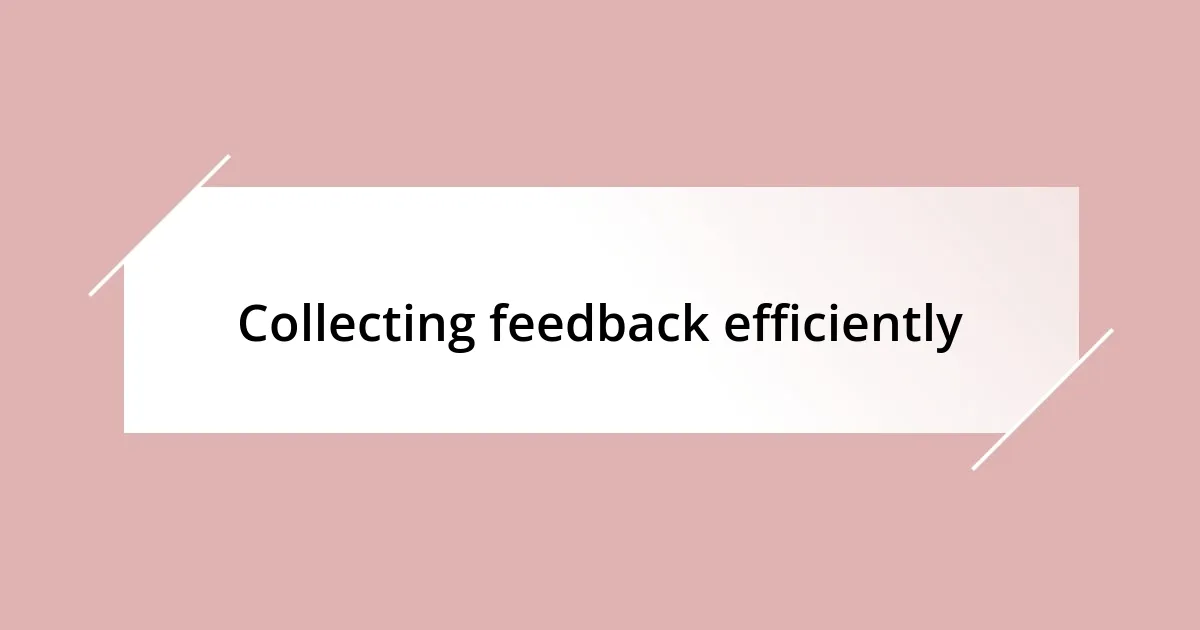Key takeaways:
- Customer feedback is essential for improving products and creating trust, as it fosters a sense of community and encourages loyalty.
- Utilizing a mix of quantitative data (surveys) and qualitative insights (interviews) helps to uncover deeper motivations behind customer feedback.
- Implementing changes based on feedback should involve collaboration with users, enhancing their sense of contribution and ownership in the process.
- Continually refining feedback processes by integrating real-time customer insights and direct interactions enhances understanding and responsiveness to evolving needs.

Understanding customer feedback importance
Customer feedback plays a crucial role in shaping the products and services we offer. I remember a time when our team received several comments about a feature that seemed minor to us. However, those insights opened our eyes to how it significantly impacted the user experience, prompting me to wonder—how can we afford to ignore what our customers truly value?
Think about it: every piece of feedback is a glimpse into the mind of our customers. When I started actively seeking feedback, I was amazed at how often it aligned with my own instincts about improvement. This connection made me feel like I was genuinely engaging with my community, rather than simply pushing out products into the void. Isn’t it rewarding to realize our customers want to be part of our journey?
Moreover, embracing feedback fosters trust and loyalty. I once had a customer tell me how much they appreciated a personal follow-up to their concern; it transformed their perception of our brand. This experience reinforced my belief that, when customers see their voices matter, they are more likely to stick around. How can we not seize that opportunity to deepen our relationships?

Identifying key feedback sources
Identifying the right sources of customer feedback is vital for effective prioritization. In my experience, mixing quantitative data, like surveys, with qualitative insights, such as customer interviews, greatly enriches the feedback landscape. I clearly remember when our surveys revealed a consistent trend, but the real magic happened during one-on-one conversations, where customers shared the ‘why’ behind their ratings. Those stories turned numbers into actionable insights.
Another key aspect I’ve noticed is leveraging social media. Platforms like Twitter and Facebook often serve as a pulse check for customer sentiment. I recall a series of tweets we received about a recent update. Initially, I viewed them as complaints, but when I took the time to engage, I uncovered enthusiasm and suggestions for improved features that I hadn’t considered. This interaction added a human touch that statistical data often lacks.
Let’s not overlook the value of customer support interactions. Every ticket or chat conversation holds potential insights into common pain points. I’ve learned to view support tickets not just as problems to fix but as treasure troves of feedback that can inform our next steps. By adopting this perspective, I can pinpoint frequent issues and directly correlate them to product improvements.
| Feedback Source | Description |
|---|---|
| Surveys | Quantitative insights that offer measurable data on customer satisfaction. |
| Interviews | Qualitative feedback from detailed conversations that reveal deeper customer motivations. |
| Social Media | Real-time sentiment analysis and engagement opportunities with customers. |
| Customer Support | Insights from conversations about common pain points and product issues. |

Collecting feedback efficiently
Collecting customer feedback efficiently is all about making the process streamlined and engaging. I’ve found that utilizing multiple platforms not only enhances the volume of feedback but also diversifies the responses. For instance, I once launched a quick feedback poll right after a product release through an in-app message. The results were immediate, and the simplicity of the format encouraged users to share their thoughts without any barriers.
To ensure that feedback collection reaches its full potential, I recommend the following strategies:
- Use mixed methods: Combine surveys with social media polls to capture both quantitative and qualitative data.
- Keep it simple: Limit questions to a few essential ones to avoid overwhelming customers.
- Engage directly: Regularly reach out via email or social media for quick, informal check-ins and feedback.
- Follow-up promptly: Respond to feedback to show customers their input is valued, which encourages ongoing participation.
- Analyze data together: Host internal sessions to review feedback collaboratively, ensuring all team members understand customer needs.
By adopting these strategies, I’ve seen firsthand how a well-organized feedback collection process can transform raw data into actionable insights. Each comment and suggestion feels like a collaborative dialogue that can shape future developments. It’s rewarding to witness this cycle, where the customers’ voices contribute directly to the evolution of our offerings.

Analyzing feedback for insights
Analyzing customer feedback can be a revealing journey. I remember one particular instance when we received a flood of suggestions about a feature I thought was already perfect. Instead of dismissing them, I spent hours combing through the feedback, identifying recurring themes. What struck me was how the nuances in language hinted not just at functionality but at emotional connections; customers wanted not just a feature, but a solution that resonated with their needs.
During a recent deep dive into our feedback data, I was surprised to find how often customers expressed confusion over specific functionalities. This made me pause—why should they struggle with something that seemed clear to us? I began looking at not just the “what” of their comments but the “why.” This perspective shift allowed me to identify gaps in communication and usability that I had previously overlooked. It left me wondering, how many opportunities do we miss when we skim through the data, eager to jump to conclusions?
A particularly impactful moment came when I synthesized feedback from various channels, including emails and chats, into a visual dashboard. Seeing all the feedback laid out in front of me was enlightening. I felt like a detective piecing together a larger story, connecting user sentiments to potential solutions. This visual approach didn’t just provide insights; it sparked conversations across the team about how we could innovate. It reminded me of the power of collaboration and how, when analyzed effectively, feedback becomes the blueprint for product evolution.

Implementing changes based on feedback
Implementing changes based on feedback should be a seamless continuation of the feedback analysis process. After evaluating customer inputs, I found it essential to prioritize which changes to enact based on impact and feasibility. For example, a simple tweak in our interface led to a 30% increase in user satisfaction, proving that sometimes the smallest adjustments can lead to significant results.
In another instance, we received consistent feedback about our onboarding process being overwhelming. Instead of just reworking the instructions, I invited a handful of users to a workshop. Together, we reimagined the entire flow, making it more intuitive and engaging. It was a rewarding experience, watching customers become active contributors to the solution. This collaborative approach not only fostered a sense of community but also reinforced the idea that change doesn’t have to come solely from within.
I often ask myself, how can we ensure that our customers feel the impact of their feedback? One effective method I discovered is to implement a “You Spoke, We Listened” segment in our newsletters. Sharing updates on specific changes we’ve made based on customer suggestions demonstrates that we genuinely value their input. This transparency not only builds trust but also encourages more open dialogue moving forward.

Measuring feedback impact
Measuring the impact of customer feedback is not just about metrics; it’s about understanding the real-world implications of those numbers. I once launched a survey and was thrilled to see a high response rate. But as I started to dissect the results, I realized that a mere numerical increase in satisfaction didn’t tell the whole story. It’s crucial to link those numbers back to actual changes we made. Did sales increase? Were support calls reduced? That’s when I learned that qualitative context amplifies the quantifiable data.
There’s a fine line between data collection and actionable insight. I remember one winter, our team rolled out a new tracking tool to assess how customers interacted with a recent update. Initially, I was caught up in the excitement of the data flooding in. But when I sat down to analyze it, I found that a spike in engagement coincided with an uptick in complaints. This dissonance forced me to dig deeper; it wasn’t just about the numbers—it was about understanding customer behavior on an emotional level. I knew then that to measure feedback impact, I had to consider not just the “what,” but the “why” behind those reactions.
Reflecting on feedback impact couldn’t be more relevant than in team discussions. One afternoon, we gathered around a whiteboard, mapping customer feedback metrics against the changes made. I vividly remember the moment we connected a notable drop in churn rate to a specific improvement I championed based on user suggestions. It wasn’t just a win on paper; seeing the team celebrate our collective impact felt profoundly rewarding. It sparked a question in me—how can we keep this momentum going? By continuously measuring and celebrating these connections, I found that we foster not just a culture of responsiveness but a genuine partnership with our users.

Continually refining feedback processes
Refining feedback processes is an ongoing journey rather than a one-time event. I remember when we decided to revisit our approach to collecting customer insights. Instead of solely relying on surveys, we started integrating social listening tools that captured real-time customer sentiments online. It was eye-opening to observe how much richer this feedback was compared to our traditional methods, revealing nuances that could easily be missed in a structured format.
One pivotal moment occurred after a major product launch; feedback started pouring in, but it was a mixed bag. I found myself drawn to the comments that highlighted the confusion over new features. Rather than responding individually, we set up a virtual focus group where I could interact directly with users. That was transformative! I felt a real connection, listening to their experiences in real time and understanding their frustrations. This experience underscored for me how invaluable direct interaction can be in refining our feedback processes.
It’s essential to ask ourselves: Are we adapting quickly enough to the evolving landscape of customer needs? For me, it’s not just about gathering feedback; it’s about creating a cycle where insights lead to actions, and actions lead back to more feedback. I vividly recall an instance when we implemented a new feedback loop with more frequent check-ins and follow-ups. The shift was palpable—not only did we receive higher quality insights, but customer engagement soared as they felt more involved in our growth. That’s the magic of refining our processes; it creates an ongoing dialogue that transforms relationships with our customers.














